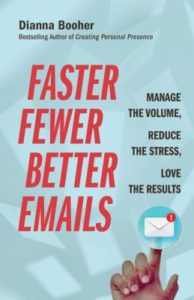


Commonly heard among coworkers: “They never got back to me.” “I guess I’m going to have to send a reminder.” “The responses are slow coming in.”
Okay, it’s a given that procrastination plays a prominent role in people not meeting deadlines. But as an email writer, you can prompt faster responses in most people who care but just aren’t that committed to deadlines set by other people. Here’s how to improve your odds in getting timely action:
Phrases such as “as soon as possible,” “at your earliest convenience,” and “ASAP” mean anything from a few hours to a few weeks to different people. Often, writers use such vague phrasing to avoid sounding demanding and to be “courteous.”
But never equate vagueness with courtesy. It’s downright discourteous to tell someone you need something “at their earliest convenience,” hoping they’ll send it no later than Friday—only to call them Thursday night at 6:00 pm to say you must have it Friday by 8:00 am.
Some readers skim only email subject lines to prioritize their work. They’ll never see your action and due date if it’s buried later within the document.
If the action and due date will not logically fit in the subject line, the next best place is in the opening sentence or the first paragraph. Then circle back to fill in details about how and why to take the action.
Be clear about what’s “in it” for the reader to respond by the deadline. Or what will be the consequences if the reader fails to comply by the deadline?
In an active-voice sentence, the subject of the sentence does the action. In a passive-voice sentence, the subject does nothing. It simply receives action.
Active: All team leaders should send their final reports to Geri Smith by June 1.
Active: Please send your final reports to Geri Smith by June 1. (“You,” the reader, is the understood subject.)
Passive: Final reports should be sent to Geri Smith by June 1. (The “doers” often disappear in passive-voice sentences. That allows people to say, “Oh, I didn’t know you were counting on me to do X.”)
Don’t make readers have to guess how to take the action. Any pause to ponder delays the action, often creating another email exchange.
Understanding the inclination to procrastinate, make things easy for response. Can you provide a link, form, or tool to take the action you want or to at least provide an example or resource as help?
If the email is longer than a paragraph or so, make the deadline for response stand out from the rest of the message. Highlight it with bolding, underlining, uppercase, or a contrasting color.
Seriously.
Learn more ways to manage your email with Dianna’s new book Faster, Fewer, Better Emails: Manage the Volume, Reduce the Stress, Love the Results. Click here for more information.
